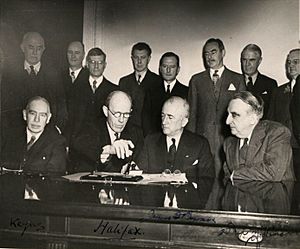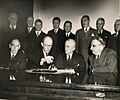Anglo-American loan facts for kids
The Anglo-American Loan Agreement was a big loan given to the United Kingdom (UK) by the United States (US) on July 15, 1946. This loan helped the UK's economy stay strong after the end of World War II.
The loan was worked out by a famous British economist named John Maynard Keynes and an American diplomat named William L. Clayton. It was for $3.75 billion from the US, plus another $1.19 billion from Canada. The interest rate was very low, just 2%. A part of the agreement caused some problems for the British economy in 1947. This was because it required Britain to let other countries change their British money (pounds) into US dollars. The entire loan was finally paid off in 2006.
Contents
Why Britain Needed Help
Before the war ended, the US had a program called Lend-Lease. This program allowed Britain and other allies to get important supplies like food and military equipment without having to pay for them right away. It was like borrowing things for the war effort.
When World War II suddenly ended in August 1945, the US stopped the Lend-Lease program. This was a big shock for Britain. During the war, Britain had focused almost all its efforts on making things for the war. This meant they weren't making many goods to sell to other countries. So, Britain didn't have much money coming in from exports.
Without Lend-Lease, Britain suddenly needed to pay for all the food and supplies it was importing. But its economy was not ready for this. Britain also needed to keep some of the equipment it had received through Lend-Lease. The Anglo-American Loan was created to help Britain deal with this sudden financial challenge and buy the things it needed.
The Loan Agreement
Getting the Loan

Britain sent John Maynard Keynes to the US and Canada to ask for money. British leaders hoped that because of all Britain's hard work and sacrifices in the war, especially before the US joined in 1941, America would offer help as a gift.
However, instead of a gift, Keynes was offered a loan. It came with good terms, meaning the interest rate was low. The US offered $3.75 billion, and Canada added $1.19 billion. Both loans had a 2% yearly interest rate. In total, Britain paid back about $7.5 billion to the US and $2 billion to Canada, including the interest.
Loan Rules and Challenges
The loan came with some important rules. One of the most difficult rules was about "sterling convertibility." This meant that after a year, countries that had British pounds (money they earned from selling things to Britain) could exchange those pounds for US dollars.
This rule caused a big problem for Britain. In just one month, other countries took almost a billion dollars from Britain's dollar savings. This forced the British government to stop the convertibility rule and make big cuts to its spending. This also showed that the British pound was not as strong as people thought. So, in 1949, the value of the pound was lowered compared to the dollar.
Even with these problems, the 2% interest rate was much lower than what banks usually charged at the time. This made the loan a "very good deal" for Britain in the long run.
Paying Back the Loan
The very last payment on the loan was made on December 29, 2006. Britain paid about $83 million to the US and about $23.6 million to Canada. This final payment was actually six years late. The British government had paused payments several times over the years. This happened when the exchange rates between currencies made it very hard for Britain to pay.
After the final payment, a British government official named Ed Balls officially thanked the US for its help during the war.
Images for kids
-
Signing the loan agreement. You can see important people like economist John Maynard Keynes (bottom left) and US Secretary of State James F. Byrnes (bottom third from left).


